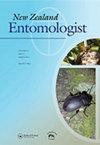新西兰大黄蜂肠道微生物群落和病原体感染(Bombus terrestris,Linnaeus,1758)
IF 0.4
4区 农林科学
Q4 ENTOMOLOGY
引用次数: 4
摘要
摘要肠道微生物组是蜜蜂健康的重要组成部分。此前全球范围内的研究表明,蜜蜂肠道微生物组可能会受到病原体的影响。我们调查了新西兰各地浅尾大黄蜂(Bombus terrestris,林奈出版社,1758)种群中存在的三种特定病原体。在所研究的地点,病原体孟买腐霉是最普遍和最广泛的病原体,在所检查的蜜蜂中,其流行率在30%至100%之间。然而,只有在北岛遗址中才发现炸弹Nosema。除一个(南岛的Twizel)外,在所有地点的大黄蜂中都检测到了变形翼病毒,其流行率在0%至60%之间。研究了来自两个不同地点的土鳖肠道微生物组和相关病原体。观察到了诸如Snodgrassella alvi和乳酸杆菌的细菌。我们还发现,家蚕感染与更多样、更独特的肠道微生物组有关,这可能表明肠道微生物群落的破坏会损害大黄蜂的健康。本文章由计算机程序翻译,如有差异,请以英文原文为准。
Gut microbial communities and pathogens infection in New Zealand bumble bees (Bombus terrestris, Linnaeus, 1758)
ABSTRACT The gut microbiome is an important component of bee health. Previous research around the globe indicated that bee gut microbiome can be affected by the presence of pathogens. We surveyed for the presence of three specific pathogens in populations of the buff-tailed bumble bee, Bombus terrestris (Linnaeus, 1758), across New Zealand. The pathogen Crithidia bombi was the most prevalent and widespread pathogen across the studied sites, with prevalence ranging from 30 to 100% of the bees examined. Nosema bombi was, however, only found in North Island sites. The Deformed wing virus was detected in bumble bees at all the sites except one (Twizel in the South Island) with prevalence ranging from 0 to 60%. The B. terrestris gut microbiome and the associated pathogens from two contrasting locations were studied. Bacteria such as Snodgrassella alvi and Lactobacillales were observed. We also found that infections with C. bombi were associated with more diverse, distinct gut microbiome perhaps indicating disruptions of gut microbe communities that contribute to impair bumble bees’ health.
求助全文
通过发布文献求助,成功后即可免费获取论文全文。
去求助
来源期刊

New Zealand Entomologist
ENTOMOLOGY-
CiteScore
0.70
自引率
33.30%
发文量
3
审稿时长
>12 weeks
期刊介绍:
The invertebrate diversity of New Zealand is of great interest worldwide because of its geographic isolation and geological history. The New Zealand Entomologist plays an important role in disseminating information on field-based, experimental, and theoretical research.
The New Zealand Entomologist publishes original research papers, review papers and short communications. We welcome submissions in all aspects of science regarding insects and arthropods in a New Zealand or Australasian setting. The journal’s subject matter encompasses taxonomy, phylogenetics, biogeography, biological control and pest management, conservation, ecology and natural history.
The journal is the official publication of the Entomological Society of New Zealand. Papers published or submitted elsewhere for publication will not be considered, but publication of an abstract or summary elsewhere (e.g. conference proceedings) does not preclude full publication in the New Zealand Entomologist. Accepted papers become copyright of the Entomological Society of New Zealand. The journal is published in English, but we also welcome publication of abstracts in Maori.
 求助内容:
求助内容: 应助结果提醒方式:
应助结果提醒方式:


